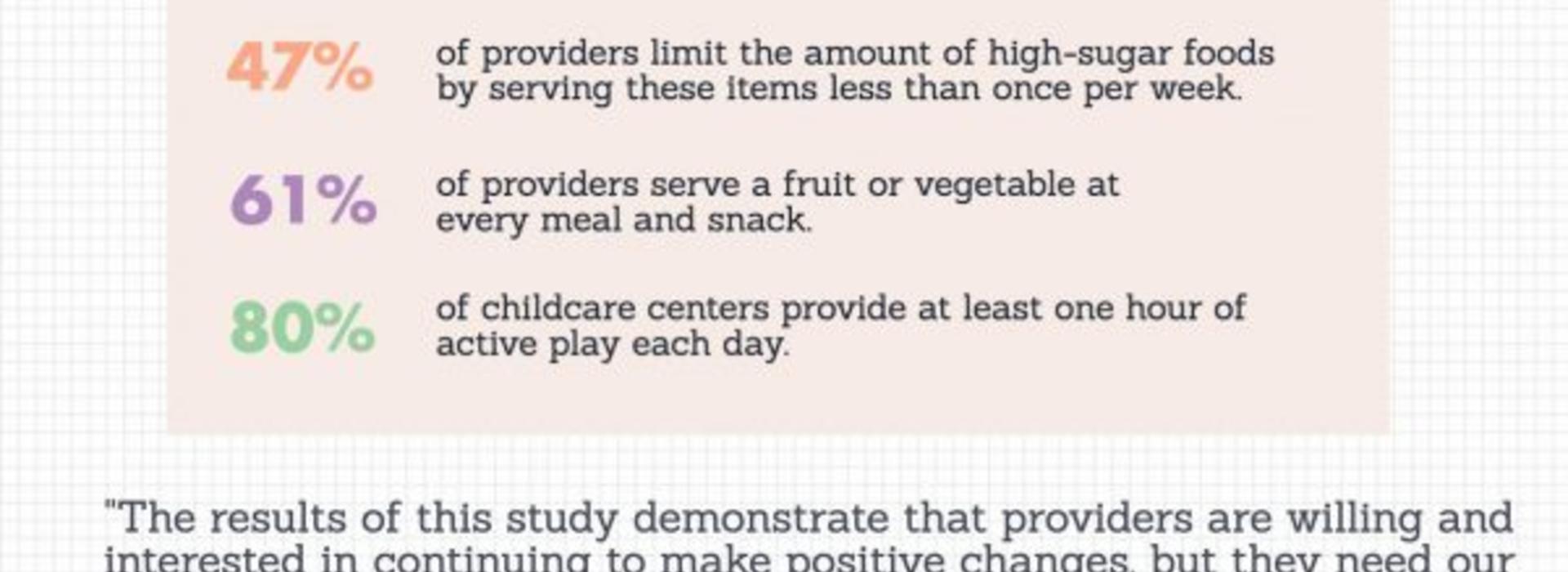
Survey Finds Early Childhood Care and Education Providers Creating Healthier Environments for Kids in Minnesota
Sixty-one percent of early childcare providers in Minnesota are serving a fruit or vegetable at every meal and snack. That’s according to a new University of Minnesota survey of licensed center- and home-based early childcare providers.
Funded by the Center for Prevention at Blue Cross and Blue Shield of Minnesota with additional support from Hunger Impact Partners, the 115-question survey shows childcare providers are making significant strides in fostering healthy environments compared to a similar 2010 survey. However, responses also indicate additional improvement can be made in critical areas, and shine light on barriers to progress.
Key findings include:
- More providers are limiting high-sugar foods, with 47 percent serving these foods less than once per week (up seven percent in centers and twenty-five percent in homes since 2010)
- 61 percent serve a fruit or vegetable at every meal and snack (up 18 percent in centers and 8 percent in homes since 2010)
- Eighty percent of childcare centers and sixty-nine percent of home-based caregivers provide at least one hour of active play each day (up twenty-three percent in centers since 2010)
- Only 33 percent are attending annual healthy eating and nutrition trainings, a decrease of 3 percent since 2010
- Only 33 percent of providers serve only whole-grain foods
“The results of this study are impactful, as they demonstrate the many ways Minnesota providers are creating healthy environments for the children in their care,” said Katie Loth, Ph.D., M.P.H., assistant professor in the Department of Family Medicine and Community Health at the University of Minnesota Medical School, who co-investigated the study.
“At the same time, these results also point out areas where we can all work together to make improvements,” Loth said. “Overall, providers are willing and interested in continuing to make positive changes; they need our support to find creative and effective solutions to the barriers they face.”
Providers named several barriers to implementing best practices. Higher cost of healthier foods and lack of time to prepare meals were the most common barriers to proper nutrition. Additionally, providers cited inclement weather and cost of equipment as reasons for less than favorable physical activity practices.
OPPORTUNITIES FOR ACTION
Fortunately, there are several action steps that can be taken by providers, parents and caregivers, and advocates. For instance:
- Providers may consider pursuing farmers markets, cooperative purchasing and farm-to-table options as creative ways to reduce costs related to healthy food
- Parents may consider helping develop policies related to healthy food and physical activity at their children’s day care, while encouraging their children to try new, healthy food options at home
Advocates are encouraged to think collaboratively about systems-level changes to improve access to healthy food and active play, to look for ways to connect providers to convenient and less expensive alternatives to traditional grocery stores, to expand training or educational opportunities, and to provide other supports for providers interested in creating healthier early care and education settings.
“We believe that providing children with healthy environments from a young age is important, as it lays the foundation for healthier lives as they grow older,” said Janelle Waldock, vice president of community health and health equity at Blue Cross, who leads the organization’s Center for Prevention. “It is critical that the youngest members of our community are provided opportunities to be healthy in early care and education settings, considering the unquestionable connection between our surroundings – the places where we live, learn, work and play – and our health.”
For more information, the full study can be found at z.umn.edu/healthystarthealthystate